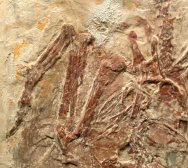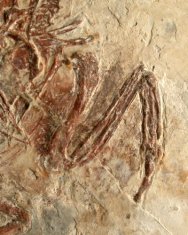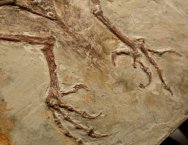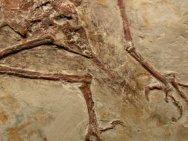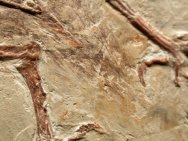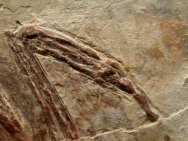|  The Enantiornithine birds at one time were the dominant group of
birds during the Creatceous, only to go the way of the dinosaurs
by the end of the perioid. Their name is derived in the meaning
"opposite birds" due to a reverse articular arrangement
between the scapula and the coracoid from the typical birds of today.
Protopteryx is the most primitive member of this subfamily, and
was described just four years ago from two wonderfully-preserved
specimens This bird sported three different types of feathers: downy
feathers for the head and body, typical flight feathers, and strange
central tail feathers. The long tail feathers appear to have
The Enantiornithine birds at one time were the dominant group of
birds during the Creatceous, only to go the way of the dinosaurs
by the end of the perioid. Their name is derived in the meaning
"opposite birds" due to a reverse articular arrangement
between the scapula and the coracoid from the typical birds of today.
Protopteryx is the most primitive member of this subfamily, and
was described just four years ago from two wonderfully-preserved
specimens This bird sported three different types of feathers: downy
feathers for the head and body, typical flight feathers, and strange
central tail feathers. The long tail feathers appear to have 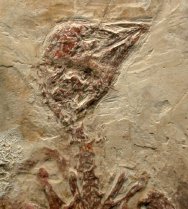 been
elongated, scale-like structures that lacked the individual barbs
seen today. This observation led the describers to postulate that
feathers may have been derived from scales by elongation, followed
by development of a central shaft. All birds evolved from feathered
dinosaurs, and there is thus taxonomic differentiation between birds
and dinosaurs. Birds survived the Cretaceous-Tertiary extinction
event and the dinosaurs did not. been
elongated, scale-like structures that lacked the individual barbs
seen today. This observation led the describers to postulate that
feathers may have been derived from scales by elongation, followed
by development of a central shaft. All birds evolved from feathered
dinosaurs, and there is thus taxonomic differentiation between birds
and dinosaurs. Birds survived the Cretaceous-Tertiary extinction
event and the dinosaurs did not.
This
specimen shows portions of preserved downy feathers, but not the
elongated tail feathers. There is insufficient data to show whether
all specimens show these elongated tail feathers. Perhaps, like
in its close relative Confuciusornis, only the males developed the
elongations. If you look closely at the skull, you can see evidence
of teeth; the first specimens found showed at total of four teeth
present. Notice too the wings. The wing claws are visible, particularly
the alular claws. The alula (or "bastard wing") is a feathered
structure which provides modern-day birds with additional lift during
slow flight. Neither Confuciusornis nor Archaeopteryx had an alula,
and so are thought to have been unable to take off directly from
ground level.
A primitive
Enantiornithine bird and the origin of feathers, Science, 2000,
290, 1955-1959. |


